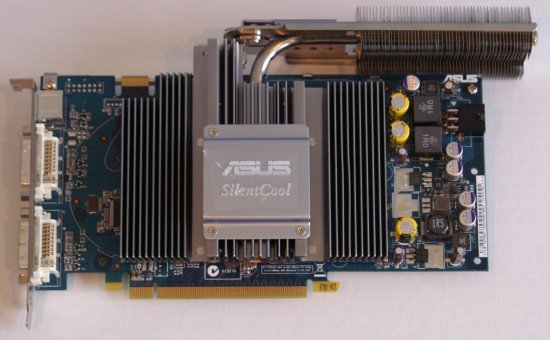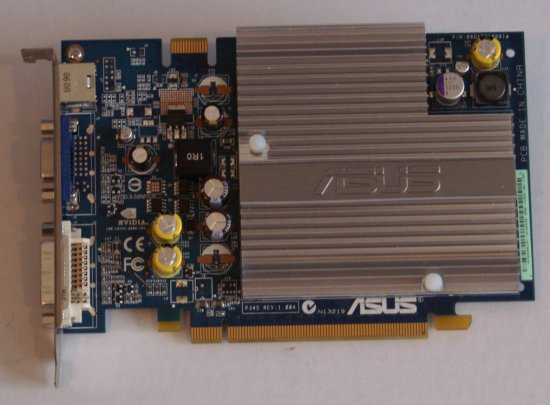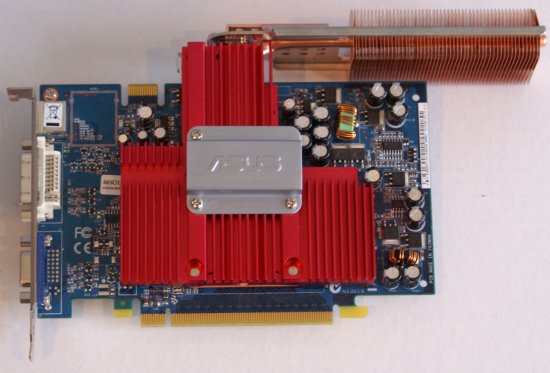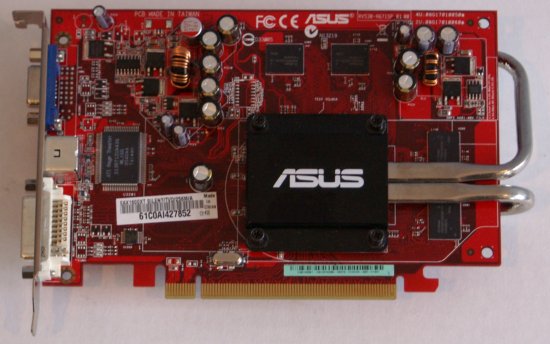ASUS
We start our silent card roundup by looking at some cards by ASUS, a company that has impressed us with its quality in the past. For this roundup, ASUS has submitted four silent NVIDIA cards and a silent ATI card.


First we have the ASUS NVIDIA GeForce EN7800 GT Top Silent, a powerful card considering its silent design. As its name implies, the EN7800GT uses NVIDIA's 7800 GT GPU. This is an interesting card because, aside from its high performance GPU, its heatsink is designed with an arm extending from the side of the card that has the ability to swivel out 90 degrees so that air being pulled from the CPU fan can provide extra cooling. The arm can also remain closed if space is an issue, and the card still works fine. This is also the most powerful silent card we have for this review, and it comes with a slightly higher factory clock than a standard 7800 GT (420MHz/1.24GHz).

Second, we have the ASUS NVIDIA GeForce 7600 GS Silent 512. As the name suggests, this card has 512 MB memory instead of the standard 256 MB and is based on NVIDIA's 7600 GS GPU. However, the memory clock speed is set significantly lower than the standard 256 MB 7600 GS (540MHz vs. the standard 800MHz). This card as well as the 256 MB version have metal heat sinks that cover the front of the card, and curl over the top and down the back about an inch.

The ASUS NVIDIA GeForce 7600 GS Silent is the 256MB version of the above card. It's factory clocked the same as a standard 7600 GS, with a 400MHz core and an 800MHz memory clock speed. Both the 512 MB and 256 MB versions of this card look exactly the same. It is possible that when Windows Vista becomes available, the added memory of the 512MB version will prove useful, but at present there's little reason to recommend having additional RAM at a slower clock speed.

The ASUS EN6600 GT Silencer is very similar in design to the EN7800 GT Top Silent, with a rotating-arm heat sink that extends from the side of the card. The EN6600 GT's heat sink is a bit smaller and lighter than the EN7800 GT, which makes sense given the 6600's smaller size. Also similarly to the EN7800 GT Top Silent, this is the only card of its kind (6600 GT) in this review. On the NVIDIA side, our main focus will be on 7600 and 7300 cards, and for ATI the X1300 and X1600 offerings.

And lastly, we have an ATI offering by ASUS: the Radeon EAX1600 XT Silent. This is our most powerful ATI card for this review, and this particular X1600 XT has an interesting heat sink design. There is a small black heat sink on the face of the card just covering the processor, and two metal heatpipes extend around the end and to the back of the card, which holds a much larger heat sink. We will list the current prices for these as well as the rest of our cards in the "Cards Summary and Prices" section later on.
We start our silent card roundup by looking at some cards by ASUS, a company that has impressed us with its quality in the past. For this roundup, ASUS has submitted four silent NVIDIA cards and a silent ATI card.


First we have the ASUS NVIDIA GeForce EN7800 GT Top Silent, a powerful card considering its silent design. As its name implies, the EN7800GT uses NVIDIA's 7800 GT GPU. This is an interesting card because, aside from its high performance GPU, its heatsink is designed with an arm extending from the side of the card that has the ability to swivel out 90 degrees so that air being pulled from the CPU fan can provide extra cooling. The arm can also remain closed if space is an issue, and the card still works fine. This is also the most powerful silent card we have for this review, and it comes with a slightly higher factory clock than a standard 7800 GT (420MHz/1.24GHz).

Second, we have the ASUS NVIDIA GeForce 7600 GS Silent 512. As the name suggests, this card has 512 MB memory instead of the standard 256 MB and is based on NVIDIA's 7600 GS GPU. However, the memory clock speed is set significantly lower than the standard 256 MB 7600 GS (540MHz vs. the standard 800MHz). This card as well as the 256 MB version have metal heat sinks that cover the front of the card, and curl over the top and down the back about an inch.

The ASUS NVIDIA GeForce 7600 GS Silent is the 256MB version of the above card. It's factory clocked the same as a standard 7600 GS, with a 400MHz core and an 800MHz memory clock speed. Both the 512 MB and 256 MB versions of this card look exactly the same. It is possible that when Windows Vista becomes available, the added memory of the 512MB version will prove useful, but at present there's little reason to recommend having additional RAM at a slower clock speed.

The ASUS EN6600 GT Silencer is very similar in design to the EN7800 GT Top Silent, with a rotating-arm heat sink that extends from the side of the card. The EN6600 GT's heat sink is a bit smaller and lighter than the EN7800 GT, which makes sense given the 6600's smaller size. Also similarly to the EN7800 GT Top Silent, this is the only card of its kind (6600 GT) in this review. On the NVIDIA side, our main focus will be on 7600 and 7300 cards, and for ATI the X1300 and X1600 offerings.

And lastly, we have an ATI offering by ASUS: the Radeon EAX1600 XT Silent. This is our most powerful ATI card for this review, and this particular X1600 XT has an interesting heat sink design. There is a small black heat sink on the face of the card just covering the processor, and two metal heatpipes extend around the end and to the back of the card, which holds a much larger heat sink. We will list the current prices for these as well as the rest of our cards in the "Cards Summary and Prices" section later on.










49 Comments
View All Comments
Leo V - Thursday, August 31, 2006 - link
...I can buy a high-end 7800GT substantially cheaper, buy a quiet Zalman 80mm low-rpm GPU cooler and run it undervolted at 7V. (In fact, I have done exactly that.) It will be cheaper, run WAY cooler, and be quieter, because I can get rid of a case fan that I would need with a "silent" card anyway.The idea of running a 50-100watt GPU with a silent cooler is dubious -- you still need a fan somewhere in your system, and the best place is closest to the hottest parts. Those parts are naturally the CPU and GPU.
Instead of "silent" (but not really) high-end cards, give us cards with heatpipes + large, slow quiet fans that can be undervolted.
Most importantly, ATI and NVIDIA please stop making 100watt monsters and follow Intel's and AMD's lead in improving power efficiency.
yyrkoon - Thursday, August 31, 2006 - link
Sorry, I cant say I would agree that a fan would be quieter than a passive solution, I dont care if you could run it at 1V, and did :)Leo V - Thursday, August 31, 2006 - link
e.g. substantially cheaper than the holy grail "silent" version of the 7800GT.
And Kudos to the companies for the inventive products and to Anandtech for covering them.
hkBst - Thursday, August 31, 2006 - link
I've been waiting for a review of the passively cooled 7900GT from MSI for a while and I was expecting it to be in here. How can it not be?Look here: http://www.msi.com.tw/program/products/vga/vga/pro...">http://www.msi.com.tw/program/products/vga/vga/pro...
DerekWilson - Thursday, August 31, 2006 - link
We sent multiple requests for cards out to 16 different graphics card manufacturers. I'd say we did pretty well with more than half of those responding.We also requested that each manufacturer send us all their passively cooled cards. If something was left out it was either because the manufacturer decided not to send it, or we weren't able to get ahold of it before our submission deadline. We tested a lot of cards and have been working on this for quite some time, so silent cards that have come out recently or were not widely available until recently will not have been included.
JarredWalton - Thursday, August 31, 2006 - link
Also, the MSI 7900GT Silent card is only available in Europe, and we did mention this in the review.haris - Thursday, August 31, 2006 - link
Any chance you could retest the cards using a mid range system. It seems kind of silly to test an FX-55 with a $50-100 video card.nullpointerus - Thursday, August 31, 2006 - link
Yet Another Silly Performance Retest Request (YAMPRR)Testing an FX-55 with a $50-100 video card is not silly; testing graphics cards' performance relative to each other requires removing all other factors including the CPU and RAM. Not everyone has a "mid-range" system, and those who do not have a "mid-range" system do not want the results skewed just to make your life easier. If you want specific performance advice for your particular system and games, why do you not join and post in the forums?
ss284 - Thursday, August 31, 2006 - link
Well considering the majority of people who are looking for midrange graphics cards have a midrange system, his request is a perfectly good one. Unless Anandtech enjoys targeting the minority of its readers it should be doing more applicable performance testing. Then again, the FX-55 isnt exactly a cutting edge processor anymore. Just scale everything back 10% and you will have a rough estimate of what performance would be like on a mid range system.nullpointerus - Thursday, August 31, 2006 - link
Yet Another Defense of a YAMPRR (YADY). *yawn*Well considering the majority of people who are looking for midrange graphics cards have a midrange system, his request is a perfectly good one.
No, it's a silly one. The point of the article is to compare graphics cards, not to make life easier for a certain group of people. People who follow this esoteric stuff religiously tend to distill the information into a more practical form. And as I said, the information he wanted is readily available in the forums. A couple of mouse clicks and a bit of typing is better than ignorantly saying the video card article is silly for not providing framerates similar to some mythical ideal of a mid-range system.
Unless Anandtech enjoys targeting the minority of its readers it should be doing more applicable performance testing.
How about you go where the information is normally provided instead of trying to turn all the front page articles into your personal system upgrade newsfeeds?
Could we just skip ahead to where everyone chimes in with their own ideas of what a mid-range system is. Does it use AMD or Intel? Single or multi-core? How much RAM? Which timings? Which system boards? Which components are overclocked?
I'll make a deal with you: get together a mid-range system that everyone will agree on, and then I will agree with you that we should conflate graphics cards testing with mid-range system testing. You see, ridding the comments section of silly YAMPRR and YADY posts will not benefit anyone if we still have to deal with all the senseless bickering about little details such as chipset revisions, features, and all the other inane griping I have seen posted when Anandtech picks out a CPU, overclocking, or RAM configuration as representative of X-range systems.